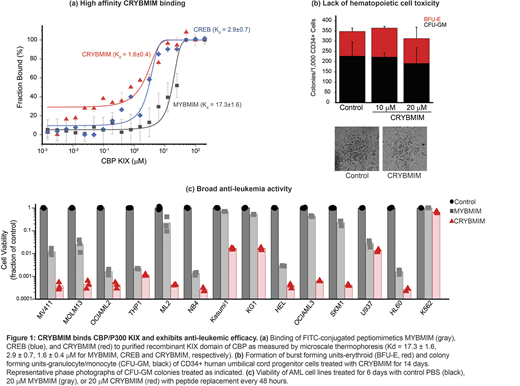Abstract
Despite a detailed understanding of the genetic mechanisms of acute myeloid leukemia (AML), treatments remain deeply inadequate. Aberrant activity of hematopoietic transcription factors and their co-activators has been implicated in the expression of leukemogenic genes, providing a compelling therapeutic target. Hematopoietic transcription factor MYB and its co-activator CREB-binding protein/P300 (CBP/P300) are required for the initiation and maintenance of a variety of acute leukemias. Using protein engineering methods, we have developed cell-penetrant peptidomimetic inhibitors that interfere with this interaction by targeting the KIX domain of CBP/P300. A second-generation inhibitor based on the chimeric interaction of MYB and CREB, termed CRYBMIM, binds CPB/P300 KIX with 10-fold higher affinity and exhibits logarithmic cell killing of most leukemia subtypes, while sparing healthy human hematopoietic progenitor cells (Figure 1). Comparative gene expression, chromatin mapping, and protein-protein interaction mapping elucidate the molecular mechanisms by which CRYBMIM dismantles oncogenic enhanceosomes, leading to the downregulation of leukemogenic gene expression in leukemia but not normal cells. Finally, we have developed a peptide-protein conjugation strategy for in vivo delivery of peptidomimetics by polyvalent reversible conjugation to transferrin (TF). We found that TF-peptide conjugates are readily taken up by AML cells and accumulate in AML nuclei, supporting their translation into new therapeutic strategies for patients. Taken together, this work advances an effective therapeutic strategy for therapeutic disruption of leukemogenic enhancer complexes, and defines mechanisms of aberrant gene expression control in AML.
No relevant conflicts of interest to declare.
Author notes
Asterisk with author names denotes non-ASH members.


This feature is available to Subscribers Only
Sign In or Create an Account Close Modal